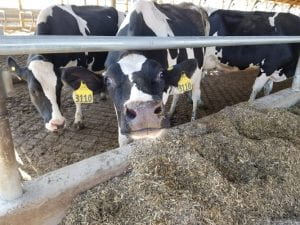By Christine Georgakakos & Betsy Hicks
Managing manure is one of the many full-time jobs that dairy farmers integrate into day-to-day operations. Many of the multi-generation farms or multiple partner farms we interviewed divided manure management and milk production responsibilities between people, easing strain and allowing specialization. We were interested in manure management from the context of reducing the spread of antibiotic resistance: questions included why farmers choose to manage manure the way they do, and what barriers exist in changing those manure systems. No farmers we interviewed identified reduction of antibiotic residues or resistant bacteria as drivers of their manure management decisions, and many were unaware that antibiotic residues and resistant bacteria can be transported with solid and liquid manures.
Nutrient management considerations
Farms across categories of management practice, size, farmer age, and farmer generation identified nutrient management as one of the key drivers of their manure management decisions. Medium to larger farms tended to emphasize the usefulness of their storage facilities, allowing them “not to daily spread and … conserve as many nutrients in…timing with our corn planting”. A small farm explained their focus on nutrient management from an environmental perspective, that “the biggest thing [is nutrient management] I was just at a meeting here a couple weeks ago about the effects that nitrogen, phosphorus, and sediment is having in the [watershed].”
Large farms also discussed nutrient management in the context of the regulations they must comply with as drivers of specific manure management decisions. Some farmers mentioned working with agencies, such as Soil and Water Conservation districts to establish management plans within regulatory guidelines – “we work with Soil and Water, use the standards and regulations, and they help us come up with protocols in place so then we can spread whatever we can spread, how much we can spread”. Smaller farms that are not inspected for state or federal regulation compliance did not mention regulations as a driver of their manure management strategies.
Funding as barrier to change
Funding was the primary barrier to modification of manure management systems. The high investment barrier deterred older and younger farmers alike from changing their systems. One Baby Boomer farmer stated “we just haven’t made the investment in a storage facility. Unless they require me, I’m going to get through to retirement without it. We’ll see. At times it would be nice to have it. But it’s a major investment. And obviously there’s nobody interested in taking the farm over. You know, I don’t see the point in making that investment.” Younger farmers similarly cited capital costs as a major barrier to changing manure systems.
Many farmers cited using existing manure systems with no additional capital costs as the primary drivers of their manure management, across the range of daily spreading to storage systems. One farmer stated, “It’s the system we have…to be totally truthful, that’s the [driver]. That’s the biggest one. That’s what we have, so it’s what we use.” Large to medium farms often expressed interest in new systems if financial barriers were overcome, especially through incorporation of new technology. Smaller farms tended to discuss desire to shift from daily spreading to other means of handling manure, such as composting systems.
Manure systems to reduce spread of AMR
Though reduction of antibiotic resistant bacteria and residue transport were not drivers in manure management strategies during our interviews, there has been research investigating manure management systems already in place on farms that achieve this goal. These methods have been shown to reduce the spread of antibiotic resistance by killing resistant bacteria or denaturing antibiotic residues. Systems shown to reduce spread of antibiotic resistance involve high temperatures to kill bacteria or denature antibiotic active ingredients. High temperature manure management systems that have shown positive results include high temperature aerobic compositing and anaerobic digesters operated at higher temperatures.
However, it is important to note that due to the chemical diversity of antibiotic residues, not all antibiotics will degrade at the same rates. Solid/liquid separation may concentrate some antibiotics in one stream over the other, but again, the chemical nature of the antibiotic in question will determine which stream it is more likely to enter. Long term storage, such as lagoons, have shown both increased and decreased residue degradation and resistant bacteria growth, and should not currently be interpreted as a method to positively combat the spread of antibiotic resistance. Studies have shown that presence of antibiotic residues has reduced microbial activity and degradation rates of manure stocks across manure management systems, so antibiotic residues may influence nutrient release and availability for crops.
Antibiotic residues, as well as antibiotic resistant bacterial genes, have been found in many places – soils where manure was spread, surface waters, vegetables fertilized with manure, and even in drinking water. They interact with us all, regardless of our own usage. Though the usage of antibiotics in animal agriculture is not the only source of environmental antibiotic contamination, it is increasingly important for each source to continue to work and make changes to reduce the impact of their usage.

